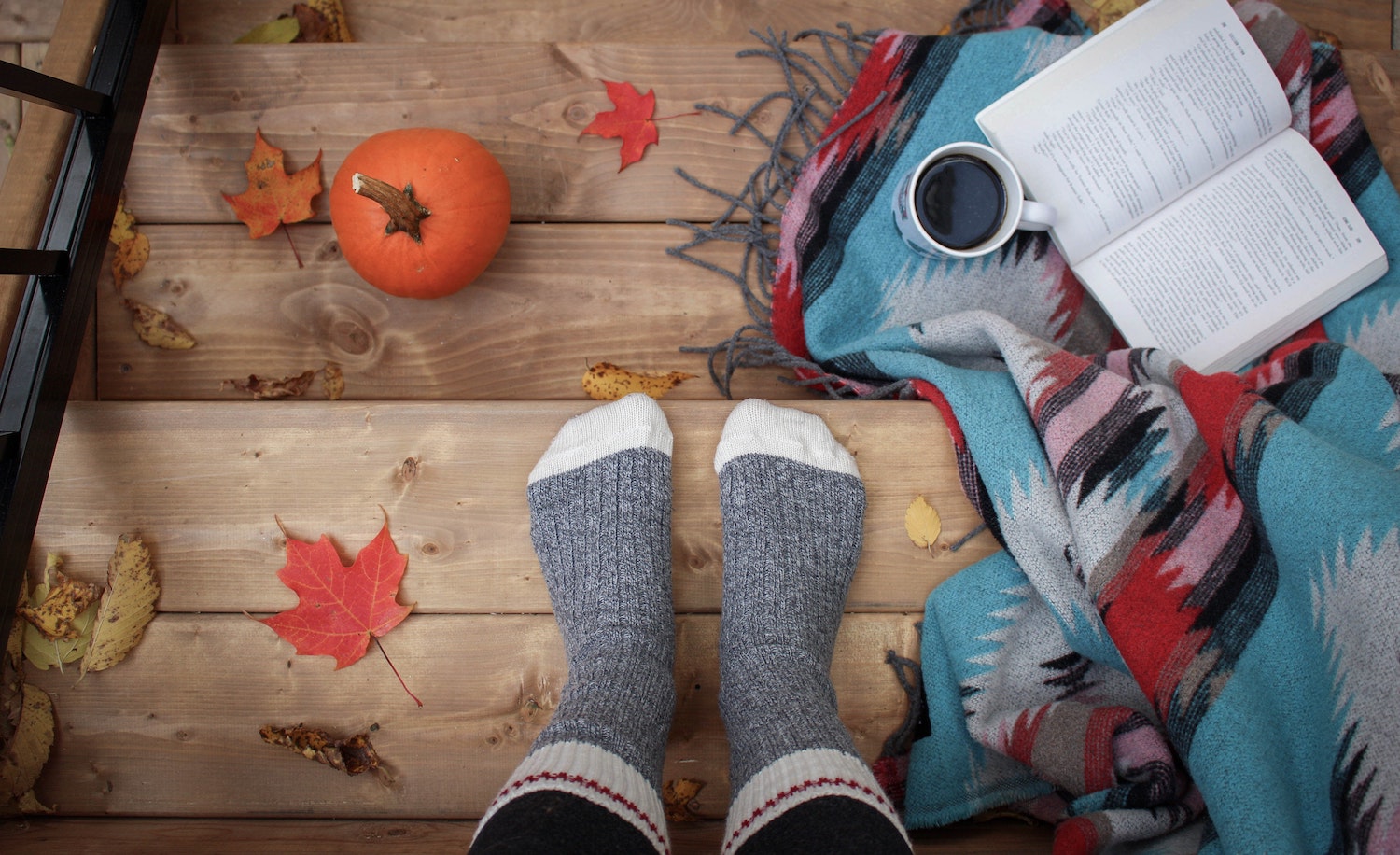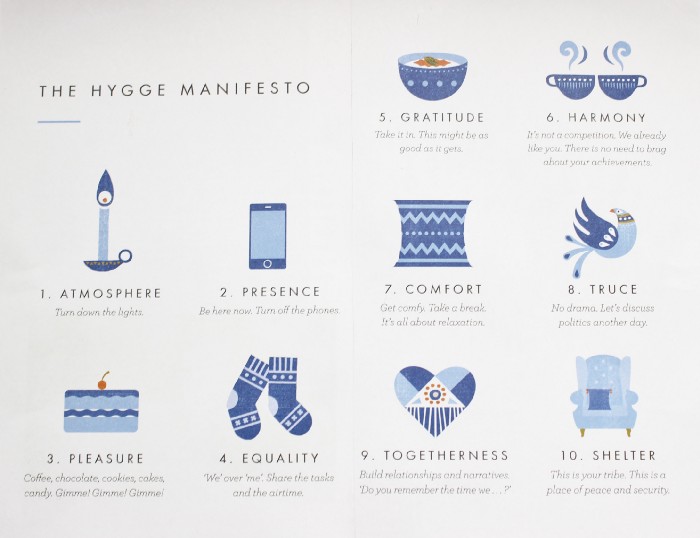4 Ways Embracing ‘Hygge’ This Fall Will Change Your Life

As an HSP, ‘hygge’ may be the best self-care regimen you can give yourself.
It was the worst autumn of my life — a time of great upheaval and one of my lowest points. After three years of working a challenging, high-stakes position, my employers decided to shutter the doors, and I was out of a job, just in time for the holidays.
Not only that, I had invested a lot of myself in that role. I remember when I first interviewed for it, a highly sensitive, self-doubting individual with crippling social anxiety, who somehow faced down the two towering owners of the company and proved to them that I was the person they needed to reinvent their communications strategy. It was the start of a long period of personal growth. But, now, I felt as though that had all been stripped away.
Meanwhile, the days were getting shorter and the prep for the holiday season was in full swing: shopping I could no longer afford, festivities I no longer felt jolly about, and the impending blustery winter months. I began to slip into a daze of winter sadness, self-blame, and isolation.
That was when a former coworker asked to meet for lunch. Over Szechuan shrimp and egg rolls, she introduced me to a Danish concept called hygge.
I can tell you, quite literally, that it changed my life.
Like what you’re reading? Get our newsletter just for HSPs. One email, every Friday. Click here to subscribe!
What Is ‘Hygge’?
Pronounced hue-guh or hoo-gah, hygge is a feeling of contentment that’s engendered by coziness and simple pleasures. Those pleasures can be anything from spending quiet time in a reading nook to having a glass of wine with a friend by candlelight to eating a delicious piece of crumb cake in a corner at your favorite bakery.
I started my hygge journey with The Little Book of Hygge by Meik Wiking, the CEO of the Happiness Research Institute in Denmark — a.k.a. what I imagine to be the greatest job in the entire world.
The essence of Wiking’s “hygge manifesto” is creating the right atmosphere, comfort, togetherness, and presence, among other things, to lead a happier and more fulfilled life. According to Wiking, this can be cultivated at least ten different ways:
- Atmosphere, especially via a cozy, soft-lit vibe.
- Presence, achieved by reducing distractions (turn off your phone!).
- Pleasure in the form of small delights, like a cookie and cup of tea.
- Equality, especially by sharing (both in chores and in pleasures).
- Gratitude for what you currently have.
- Harmony, achieved by avoiding bragging and competitiveness.
- Comfort in the form of regular breaks or taking time to enjoy things.
- Truce, basically letting politics, arguments, and other divisive topics rest. (Yes, even in an election year!)
- Togetherness with a focus on building stronger relationships.
- Shelter, not just as physical places of peace, but taking shelter in the company of people who make you feel welcome and safe.
I grasped hygge immediately — I think anyone who is sensitive to their surroundings will — and found that for a highly sensitive person (HSP), it’s the best self-care regimen I’ve ever given myself. It’s made me calmer, helped me process my emotions and avoid feelings of overwhelm, and cut overstimulation out of my life (mostly!).
And I think it can do the same thing for other HSPs, too.

4 Ways Hygge Will Change Your Life
1. Hygge turns recharging into your default mode.
Whether it’s simply acting as a caretaker and advisor for everyone around us, work stress, home stress, or just the complexities of our own minds, life can be hard for us highly sensitive people.
However, creating a soothing atmosphere, ridding oneself of meaningless clutter, and giving yourself permission to decompress is at the core of hygge.
The idea is to make your space calm and peaceful, or hyggeligt — decorating with neutral hues and relaxing your senses with pleasing scents, easy lighting, and a cup of tea, and perhaps including a few houseplants — all to create a warm and safe environment.
Incorporating these simple hygge elements have greatly reduced my anxiety levels and enabled me to be more present. Unplugging for an hour or two and relishing in my own kind of quiet re-energizes my soul and makes me feel great, emotionally and physically.
2. It makes social interactions peaceful and enjoyable — instead of overwhelming.
A large group of coworkers are gathering at a popular restaurant on a Saturday night? I’ll pass.
Invited to a big birthday bash or a friend’s over-the-top wedding? I’ll send a gift in the mail.
One misconception I’ve heard others say about highly sensitive people is that we can’t handle fun, or even that we don’t like being around people. The truth is, we just get overstimulated easily if things are too big, too loud, or too busy. For me personally, although I love my alone time, I don’t like being lonely.
For as long as I can remember, I have always been extremely shy around people — sometimes even those I know and care about deeply. My tendency to tire easily and isolate myself from events and happenings has led me to feeling different, judged, or as though I were missing out on all the fun.
It’s not that I don’t want friends or relationships; it’s just that I often feel afraid and uncomfortable putting myself out there.
People have referred to hygge as “socializing for quiet people,” so it’s only fitting that it would help highly sensitive people with building the social connections they crave and making lifelong memories — without the overstimulation.
For example, hygge promotes small gatherings with family and friends over large, overwhelming get-togethers. Perhaps it’s meeting two or three people at a cozy café, or inviting a small handful of your closest buds over for a potluck dinner and card game. Maybe it’s an afternoon picnic at the park.
Cultivating hygge has made it much easier for me to enjoy calmer gatherings or outings with a few friends at a time, build deeper bonds, and become more involved in the world.
Need to Calm Your Sensitive Nervous System?
HSPs often live with high levels of anxiety, sensory overload and stress — and negative emotions can overwhelm us. But what if you could finally feel calm instead?
That’s what you’ll find in this powerful online course by Julie Bjelland, one of the top HSP therapists in the world. You’ll learn to turn off the racing thoughts, end emotional flooding, eliminate sensory overload, and finally make space for your sensitive gifts to shine.
Stop feeling held back and start to feel confident you can handle anything. Check out this “HSP Toolbox” and start making a change today. Click here to learn more.
3. It’s designed to overcome SAD and get you through all four seasons.
Hygge is often associated with winter months when the temperatures are below freezing, the days are shorter, and it’s easier to sink into an emotional low. I think it’s perfect for autumn as well, when you have a nesting instinct and can set the tone for the upcoming months.
However, Seasonal Affective Disorder (SAD) is real and painful for a lot of HSPs, and it doesn’t just occur during the fall and winter seasons. For some, the transition to spring and summer is just as challenging.
Thankfully, hygge can be embraced all year round.
Whereas vanilla-scented candles, creamy comfort foods, thermal socks, and curling up with a knit blanket are more of a January pastime, you may be more inclined to welcome the sunnier days ahead with some spring cleaning and natural light.
Save cinnamon and clove for winter and whip out citrus and floral scents in the spring and summer — and musky, earthy scents in the fall. During autumn months, go apple picking, bake a pie, and invite a couple friends for a hot beverage on the patio, porch or deck. In the warmer months, visit a produce stand for locally grown fruit and vegetables, then have a couple people over for a backyard lunch. Grow a garden.
As an avid reader, I even move my “book nook” outdoors to the patio.
As a highly sensitive person, I have found that my comfort needs are never-ending. But with hygge, I have been able to move forward with the seasons and have learned to enjoy special moments associated with each of them.
4. Hygge helps me organize my thoughts, reflect on my life, and refocus my attention.
Like many highly sensitive people, I do a lot of worrying and overthinking — which is part of how we process things so deeply. Often, this ruminating is about what I want to do with my life and career, and if I’ll ever conquer my dreams. This leads to being overstimulated by my own inner thoughts and having even greater emotional sensitivities.
When I’m most relaxed, however, I think more clearly. Hygge has decreased my anxiety and allowed me more time to reflect on the things that bring me the most joy. In a sense, it’s allowed for greater meditative moments.
I love writing, so I blog. I enjoy academia, so I am seeking employment at a college. I unplug when I need to so I can accomplish more and become more present in everyday life.
I have also become more aware of my own feelings and can recognize when I’ve reached my limit on how much stimulation I can take or when I need to take a break and recharge. And when I do recharge, I make sure I have all the elements (my simple pleasures) to do so at my fingertips: a novel, my dog, and a cozy spot that’s my own.
Most importantly, hygge has helped me accept myself for the way I am — for better or worse.
Hygge is something we all innately possess, so it’s possible that you, as the reader, have already created a hyggeligt space for yourself, or choose to partake in small gatherings with close friends in lieu of chaotic, bustling functions.
While I still struggle with social anxiety and the challenges of being highly sensitive, embracing hygge and altering how I use it throughout the year — depending on the season — has helped me build a greater awareness of self and recreate joyful memories and cherished moments. Just because I have a sensitive nervous system doesn’t mean I don’t want to be happy or have fun — and that, I’ve realized, I do have control over.
You might like:
- How to Create Your Own HSP Sanctuary
- ‘Forest Bathing’ Is a Thing, and It Can Heal Highly Sensitive People
- The Science Behind Why Highly Sensitive People Need Time Alone
A version of this post originally appeared at our sister site, Introvert, Dear.
This article contains affiliate links. We only recommend products we truly believe in.
